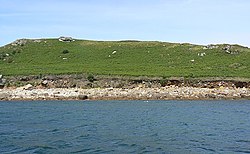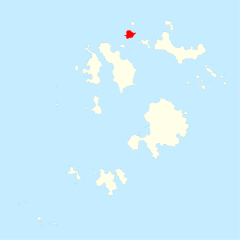St Helen's, Isles of Scilly
| St Helen's Cornish: Enys Elidius | |
 St Helen's | |
|---|---|
| Location | |
| Grid reference: | SV900170 |
| Area: | 49 acres |
| Data | |
St Helen's is one of the fifty or so uninhabited islands in the Isles of Scilly and has an approximate area of 49 acres. The island is a Site of Special Scientific Interest[1][2] and some features have been given the designation of scheduled ancient monument. Currently the main way to gain access to the island is through chartered or private boat,[3] although there are some season trips throughout the summer.[4] St Helen's is currently managed by the Isles of Scilly Wildlife Trust.
Contents
History
Early Christian Chapel
On the South Slope of St Helen's there is an early mediæval religious complex that is thought to be the remains of St Elidius’s Hermitage, an 8th century chapel lived in by Saint Lide (also known as Elid or Elidius) which is also Saint Lide allegedly burial place. Archaeological excavations suggest that the site developed from a solitary hermit site, with a single round hut and oratory, to a communal hermitage with a number of rectangular huts for individual accommodation, surrounding the church and oratory buildings.[5] Five graves from the early hermitage were also excavated east of the living section. A field system was also present providing food for the Hermitage/Chapel, and later the Pest House residents.[6] In the early 11th century a small church was built on the north east side of the living section and around 1120 AD the church was granted to Tavistock Abbey.[7] This increased the numbers of pilgrims visiting the site due to it being the shrine of Elidius, and many alterations and remodeling were made to the complex.[3] Additionally, further excavations of the site have uncovered decorated ridge-tiles and parts of the 12th century Purbeck Marble shrine that is thought to have once housed Saint Elidius relics.[8] It is also said that there was once a causeway from abbey church at Tresco across the downs to the church on St Helen's Isle.[9]
St Helen's Pool
St Helen's Pool is a stretch of water just off St Helen's island which traditionally provides provided some sheltered anchorage for shipping,[10] though there is a chance ships may experience swells near high water.[11]
There is evidence to show that during the later mediæval period the monks of Tresco may have collected tolls from ships for anchorage in St Helen's Pool, as it is considered that it was the main harbour of the islands in mediæval times.[12]
The Pest house
St Helen's Isolation hospital, also known as the Pest House, was a quarantine station built in 1764[13] to house plague cases from visiting ships calling at Old Grimsby and St Helen's Pool. It was built after an Act of Parliament in 1754 decreed that any plague-ridden ship north of Cape Finisterre bound for a British port should anchor off this island.[14] The station included the building of an isolation hospital as well as a slipway and an extensive quay to serve it.[15] The hospital building is a rectangular roofless building 7m by 5.5m externally with a two-roomed extension on its east side. The walls of the building are 2 feet thick, 10 feet high, and are constructed of mortared rubble with other details picked out in larger stones. The building has recently been repaired and stabilized to prevent its collapse with the help of English Heritage funding. There is also a graveyard associated with the pest house which is known to include the grave of a 27 year old naval surgeon who was sent to treat the sick and died within a week himself, and various passengers from Africa and Asia who also died at the station.
Cairns
The platform cairns on St Helen's make up a large amount of the total 387 surviving cairns on the Isles of Scilly, and so has been registered as an ancient monument. The remaining Bronze Age cairn field on the island consists of four ring cairns on the slight northwest-facing slope. The first cairn is 13 feet in diameter with a ring of earth with protruding spaced stones, 3 feet wide and 8 inches high. The second cairn is oval 13 feet by 10 feet with a ring 16 inches wide and 8 inches high, incorporate two contiguous slabs embedded on edge. The third cairn is 20 feet in diameter with a ring with spaced stones averaging 3 feet wide and 1 foot high. The fourth cairn is 13 feet in diameter with a ring of spaced stones which averages 2 feet 4 inches wide and 8 inches high.[16]
References
- ↑ "UK033-Isles of Scilly". http://www.birdlife.org. http://www.birdlife.org/datazone/sitefactsheet.php?id=2499. Retrieved December 2, 2011.
- ↑ "St Helen's (With Northwethel & Men-a-vaur)". Natural England. 10 December 1986. http://www.sssi.naturalengland.org.uk/citation/citation_photo/2000319.pdf. Retrieved 13 February 2012.
- ↑ 3.0 3.1 "St. Helens". http://www.ios-wildlifetrust.org.uk. http://www.ios-wildlifetrust.org.uk/living_landscapes/our_wildlife_and_historic_sites/st_helens. Retrieved December 2, 2011.
- ↑ "Important Information". http://www.simplyscilly.co.uk. http://www.simplyscilly.co.uk/site/about-scilly/important-information. Retrieved December 2, 2011.
- ↑ "Introductions to Heritage Assets-Hermitages". http://www.english-heritage.org.uk. http://www.english-heritage.org.uk/publications/iha-hermitages/hermitages.pdf. Retrieved December 2, 2011.
- ↑ "St Helen's Field System". http://scillypedia.co.uk. http://scillypedia.co.uk/LetterS.htm. Retrieved December 2, 2011.
- ↑ "Isles of Scilly". http://www.naturalengland.org.uk. http://www.naturalengland.org.uk/Images/jca158_tcm6-5510.pdf. Retrieved December 2, 2011.
- ↑ "Collection Summary-Isles Of Scilly Museum". http://www.cornucopia.org.uk. http://www.cornucopia.org.uk/html/search/verb/GetRecord/3320. Retrieved December 2, 2011.
- ↑ Jessie Mothersole. "The Isles of Scilly-Their Story, Their Folk & Their Flowers". http://www.archive.org. http://ia700303.us.archive.org/8/items/theislesofscilly00moth/theislesofscilly00moth.pdf. Retrieved December 2, 2011.
- ↑ "Valhalla - Friar Tuck 1863". http://www.tresco.co.uk. http://www.tresco.co.uk/what-to-do/abbey-garden/valhalla_friar_tuck.aspx. Retrieved December 2, 2011.
- ↑ "Isles of Scilly Cruising Guide". http://www.alphatozulu.com. http://www.alphatozulu.com/cruising_guide/UK/south_west/isles_of_scilly_cruising_guide.html. Retrieved December 2, 2011.
- ↑ Charles Johns, Richard Larn, Bryn Perry Tapper. "Rapid Coastal Zone Assessment for The Isles of Scilly". http://www.english-heritage.org.uk. http://www.english-heritage.org.uk/publications/isles-of-scilly-rczas/islesofscilly20080116095450.pdf. Retrieved December 2, 2011.
- ↑ "Pest House, St. Helen's". http://www.simplyscilly.co.uk. http://www.simplyscilly.co.uk/site/things-to-do/pest-house-st.-helens-p1153313. Retrieved December 2, 2011.
- ↑ Murphy, Peter: ’’The English coast: a history and a prospect’’
- ↑ "Meeting report from SW Soundings No.44 (Feb 1999)". http://www.swmaritime.org.uk. http://www.swmaritime.org.uk/article.php?articleid=255&atype=m. Retrieved December 2, 2011.
- ↑ "Two Kerbed Platform Cairns 240m North of the Pest House, St Helen's". http://www.ancientmonuments.info. http://www.ancientmonuments.info/en15431-two-kerbed-platform-cairns-240m-north-of-t. Retrieved December 2, 2011.
Outside links
| ("Wikimedia Commons" has material about St Helen's, Isles of Scilly) |
| Isles of Scilly |
|---|
|
St Mary's •
St Agnes •
Tresco •
Bryher •
St Martin's •
Gugh
|
